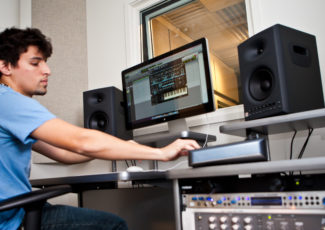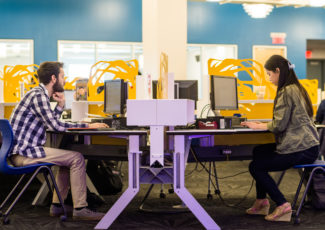Using Technology to Boost Student Retention
By Emily Rogan
May 11, 2016
The winner of the AACC Award of Excellence for Faculty Innovation shares how iPads have helped increase student retention and completion.
Angela Heaton, chair of the physical therapist assistant program at Rhodes State College in Lima, Ohio, received this year’s AACC Award of Excellence for Faculty Innovation. Heaton won the award for her work using iPads to help her students stay on track and graduate with a physical therapy assistant degree.
The idea to introduce tablets into the classroom was born in 2011, during a road trip back from a conference in Chicago. Angela Heaton and three colleagues were trying to figure out how they could use technology to improve student success.
Heaton oversees the physical therapy assistant program at Rhodes State College. Many of her students are juggling school, work and family responsibilities, and she noticed retention rates in the program were slipping.
She wanted to make it easier for her students to study, practice techniques, and access and share information. With iPads, her students could take notes and review videos, class e-mails, lab assignments and supplemental diagrams all in one place. They wouldn’t have to spend time in busy computer labs.
“I knew that the students in my program who maybe were not being successful could have been [if they’d had] a tool to maximize their time,” Heaton says.
Heaton and her team asked the college president if they could supply iPads to students. The president loved the idea and agreed to fund 40 iPads for a pilot “to assess if this was a model we can use across campus,” Heaton says. She wasn’t comfortable asking students to pay for their own devices since it wasn’t certain that the program would succeed.
The pilot ran from 2011 to 2014, and it was indeed a success. Student retention for the cohort completing the program in 2016 was 93 percent, up from 62 percent when the pilot began. Today, iPads are required for the physical therapy assistant program, and students willingly purchase them.
This was not technology for technology’s sake, Heaton emphasizes. “We wanted it to be meaningful and impact students.”
How iPads promote student success
The tablets are loaded with the Canvas learning management system, which allows students to download all of the course material in PDF format. They use their devices to photograph and store pages from their textbooks rather than lugging heavy books around. Students can also access archived audio files of lectures, so they can listen to them as many times as needed, whenever it’s convenient. And they can take practice licensure exams on their iPads.
In addition, students take photos of muscle and bone models in labs; then, using an app, they practice labeling and identifying different parts of the anatomy. “It’s like having a lab at home,” Heaton says.
The tablets allow faculty to film all skills demonstrations and exercise techniques, which are then posted on iTunes University. Students watch the videos and come to class prepared to ask questions. “It gave them more time to practice,” Heaton says, “and they didn’t have to spend extra hours outside of lab time to become competent in the skill. They could refer to the video for hand placement or machine setting.”
Staff members can now assess students during their clinical rotation using FaceTime rather than driving all over the region, saving both time and money.
Advice for others
Before launching a similar initiative, Heaton offers these tips:
- During orientation, teach students everything they need to know about the tablet, so they will be comfortable with the devices before coursework begins.
- Make sure the campus tech infrastructure is ready for tablets in the classroom. At Rhodes, IT staff needed to set up hotspots in classrooms so 30 students could simultaneously use the Internet.
- Map out course design, test it and pay attention to details. Heaton and her team practiced everything step by step before launch, even using the college president as a “student” to determine whether the sequencing worked.









